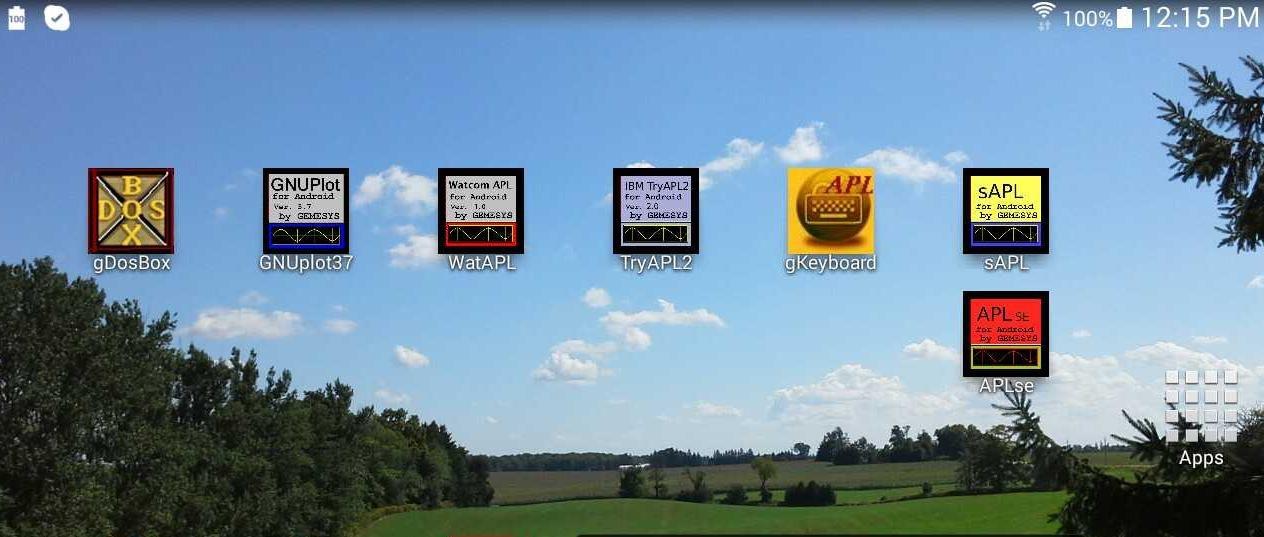Thoughts on an AI "Augmenter". The Future of AI?
The freeware APL, APLSE, can be run on the iPad, using appropriate emulation. As an example, I calculate and generate a graphic of the Logistic Equation phase-space, as a fractal example. For those who study or work with fractals and Chaos Theory, the "Tent Map" is well known. That was my first example.
I also have GNUplot37 running on the iPad and it is available from the Google Playstore as an Android app (no adverts, no in-app monitoring, no scams) , and it can be used to visualize a variety of numeric datasets. Three examples are shown below (all running on my customized, jailbroken iPad, which once jailbroken, functions as an effective Linux/Unix tablet computer.)
The electrostatic field display (see the hundreds of tiny, pointing vectors?), is an example from the GNUplot37 demo programs. It takes about 12 minutes to run on the iPad, but the information it conveys is impressive.
As straightforward economic series - London Gold price 10:30 AM fixing, daily-data, from 1965 to 2016 is shown. If you look at long duration, accurate price-series, you can see the mechanism of market dynamics fairly clearly. The boom-bust sequences in the spot gold market are typical of *all* financial markets. That is why the attempts by American and European legislators to over-protect the financial system are deeply misguided. Markets *require* the freedom to bankrupt foolish people who mindlessly follow trends, and enrich those who deploy risk-capital in places where real risk is present. Risk needs to be recognized as a very real part of how markets do their job. Remove risk, and you remove the effective, allocative intelligence of market behaviour. Political people are often quite unable to grasp this simple truth. Prices have to *move* and sometimes, move *a lot*, in order to do their job correctly. Blaming markets for bad outcomes, is as unwise as blaming oxygen for causing a fire.
The last iPad display example shown is 3-d graphic showing a surface generated by a trigonometric function, again GNUPlot37 on my hacked iPad.
My Vision for the AI-Augmenter (or AI-Helper..)
My vision for the AI-Augmenter (or AI-Helper), involves having a series of well-trained neural networks on a tablet device, and being able to interrogate them with current data, and get an "opinion" from them - and possibly display this amalgam of the AI's opinion in a graphic format that a human is comfortable interpreting - perhaps like a cross between the electrostatic field display (a bunch of little pointing vectors), and the 3-d surface, shown in the last example.
Examples of Xerion running the simple Xor2 network on a Linux development box are shown, as is an example of TensorFlow (the Google AI toolset, recently open-sourced), running on my MacBook Pro. I find working on the MacBook Pro annoying and irritating, and just getting Python to successfully load and access all the libraries needed to run TensorFlow was more work than porting Xerion to a modern Linux, and getting a clean compile from the source. I had to down-convert Tcl/Tk from 8.5 back to 7.6 and such, but that was not a huge hardship or difficult exercise. The MacBook Pro hardware is very fine, but the Apple software is carefully designed to aggressively benefit Apple, regardless of the grief it causes independent developers.
Given that Microsoft was accused of being a "monopoly", and faced lawsuits for simply including a browser in its Windows O/S, I remain astonished by the extensive, and unchallenged use of monopolistic strategies that Apple gets away with. They have restrictive dealer pricing, a "you-can-only-do-your-business-through-our-company store" policy that is a classic strategy of a monopolist, and they want additional cash-payments just to access development tools that are required to write computer programs that are to run on other Apple hardware. In the 1970's, when IBM attached similar restrictions to their mainframe machines, they were successfully prosecuted by the US Justice Department for monopolistic, anti-competitive behaviour. I like Apple hardware (which is built off-shore), but the code inside iOS that initiates the "Killed: 9" response when I attempt to run a gcc-compiled C-program, seems more like a monopolist's strategy, than it does a legitimate attempt to protect the system integrity. (See the "GNU gcc & Lynx" section, top line of this site to see what I am referring to.)
Very recently, Google has annouced it will offer (as open-source), something called "TensorFlow-Lite", which will allow a subset of TensorFlow to operate on a tablet. This is a very wise idea, and typical of the cleverness the Google folks demonstrate. The most effective place for an AI tool is right in the hands of the client.
And this is key: It has to be *unique*. If AI is to have any benefit for me - especially in a complex, dangerous, tactical situation - it will have to offer something unique that only I have - it must offer me an *edge* of some sort. It need only be a tiny edge (as most are), but it will be the capacity of AI-Helper tools to offer that custom edge, that will make them quickly indespensible. Once your "AI-Helper" gets understood to be offering you a real, actionable advantage - it will quickly become essential - like a telephone was to a stock-broker of old, or an automatic assault rifle is to a soldier in the battlefield.
The two iPad images below, were made with GNUplot37, which runs on the jailbroken iPad, under the DOSbox port, called "DOSPad-Gsys". The old Ver. 1.0 iPad can be a fully-functional, and useful computer, once the Apple iOS restrictions are bypassed. The field-lines display is particularly interesting, as it requires substantial floating-point math calculations to create. [That image removed.]


